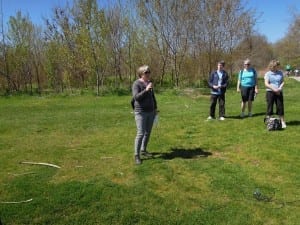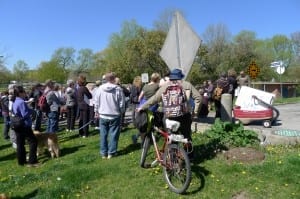How do you make a Jane’s Walk into a conversation?
During planning for the May 6, 2012 South Long Branch Jane’s Walk, local resident David Switzer pointed out for us a distinction between a Jane’s Walk and a Heritage Walk.
We’ve also heard that every Jane’s Walk will be different, depending on who’s involved with it.
Thus it may happen that occasionally a Jane’s Walk may be similar to a Heritage Walk. In fact a Heritage Walk can be re-purposed as a Jane’s Walk.
A key difference, however, is that a Jane’s Walk will typically be more in the nature of a conversation and a Heritage Walk may — as I understand — be more of a top-down dissemination of information about a neighbourhood.
The concept that a Jane’s Walk is in the nature of a conversation had a strong impact on the planning of our recent Jane’s Walk in Long Branch.
How do you make a Jane’s Walk into a conversation?
We planned from the outset that two Jane’s Walk Guides would lead the walk — in this case Mike James and Jaan Pill. They took turns at the microphone during the walk. Sometimes they had a brief conversation, passing the microphone back and forth between them.
We also made a point to welcome any walk participant to step forward, at any point, and speak to the audience.
Several speakers responded to the call for guest speakers.

Ward 3, Etobicoke-Lakeshore, Toronto District School Board Trustee Pamela Gough speaks near the Mississauga-Toronto border on May 6, 2012
Ward 3, Etobicoke-Lakeshore, Toronto District School Board Trustee Pamela Gough and several other speakers shared valuable information with us during the walk.
This made for an interesting and balanced way to share information. It’s great to hear more than one point of view.
After the walk, when I visited Mike James in the older part of Brampton where he’s lived for close to thirty years, he mentioned a drawback of having eighty people at a Jane’s Walk. There are fewer opportunities for a walk participant to share information by speaking with a smaller group of other attendees.
On a future occasion, we would plan to have two or more portable amplifiers with us, and would possibly break into two or three smaller groups.
Routes can be planned beforehand, so that if a larger group breaks into two or three smaller groups, the groups would not be running into each other.
By way of planning for the 2013 Jane’s Walks, I’ll be interested in having further conversations with Fanny Martin, Jane’s Walk Event Manager, and other organizers, to generate ideas on how to include additional opportunities for conversations as part of Jane’s Walks.
How can we work with insights from Jane’s Walks?
Fanny Martin has mentioned that it would be a great idea to get a sense of the insights and reflections that emerge among participants in a Jane’s Walk.
I look forward to learning how to gather such insights.
For a start, when we contact people who shared their emails with us during the South Long Branch walk on May 6, 2012, we’ll ask them to share their insights and reflections.
A formal evaluation form, distributed at the end of a walk, may be another way to gather views from all participants.
Conversation
A conversation can be compared to a tennis match, in which turns are taken. The ball goes over the net. The opposing player hits the ball back over the net, and so on.
In a presentation that is proceeding smoothly, the speaker is tuned into the body language of the audience, and makes subtle adjustments in speaking style and content is response to cues from listeners.
The choice of words, and the delivery of them, can be viewed as part of an ongoing conversation — part of an ongoing tennis match, so to speak.
If a speaker seeks to deliver a stream of words with barely a look at the audience, we can say that it’s a one-sided form of conversation. However, that’s a form of public speaking that will work great if a person is getting used to speaking in front of an audience.
One needs to start somewhere. Just getting started in public speaking, if one has not engaged in it very much before, is a tremendous achievement and warrants celebration. In that regard, I speak from my own experience over the years.
The ideal content, in my experience — as a speaker and as a listener — for an event such as a Jane’s Walk, consists of brief, well-chosen sounds bites from a variety of speakers.
The nonverbal communication — eye contact, smiles, nods, gestures — between speaker and listeners is qualitatively different from the nonverbal communication that occurs when an audience encounters a ‘grocery list’ style of speech, in which massive amounts of text wash over an audience.
May 2012: Five key messages about South Long Branch
For the May 6, 2012 South Long Branch walk, the key sound bites (which I rehearsed, and in some cases have used in previous presentations) were as follows:

Jaan Pill (holding microphone) explains, at start of the Jane's Walk, that Lake Promenade used to extend far beyond the point where it currently ends. Mike James is standing next to Jaan Pill. Click on photo to enlarge it. Click again to enlarge it further. Photo credit: Peter Foley
(1) Lake Promenade used to extend a significant distance to the west of where it now terminates, at Forty Second Street.
(2) The western branch of Etobicoke Creek ran on the west side of the island that used to be located directly west of the current channelized version of Etobicoke Creek.
(3) The two branches of Etobicoke Creek joined to create a stream of water which entered into Lake Ontario roughly where Applewood Creek is now located.
(4) On August 25, 2011, Etobicoke-Lakeshore MPP Laurel Broten announced that the province would provide $5.2 million to ensure that Parkview School remains in public hands.
(5) After military service with the Queen’s Rangers in the American Revolutionary War, Colonel Samuel Smith applied for and was granted a large tract of land in 1793 in Etobicoke. Originally a log cabin to which extensions and siding were added, the colonel’s house was in continuous use for about 152 years from 1797 until about 1949. When the house was demolished in 1955, the original log cabin was discovered inside the building.
These sound bites provided new information about Long Branch for a good number of the May 6, 2012 walk participants.
May 2013: Draft of five key points about South Long Branch
In a subsequent Jane’s Walk, we may review some of these points but the key sound bites will be different. Among other things, these points might include these facts:
(1) Palaeo-Indian nomadic hunters arrived in this area about 10,000 years ago at the end of the last ice age.
(2) The shoreline of Lake Ontario has wandered north of the current location during the Glacial Lake Iroquois phase when the lake expanded, and south of it during the Admiralty Lake phase when the lake contracted.
(3) An underwater valley associated with Etobicoke Creek exists south of the current shoreline, dating from when Lake Ontario was significantly lower than it is now.
(4) The evolving concept of ‘cottage country’ in the history of Southwestern Ontario
(5) Turrets, verandas, and porches: An overview of ‘cottage country’ architectural styles dating back from the creation of Long Branch Park in the 1880s
Rehearsal
For a typical speaking situation, I’ll prepare a text in 14-point font, widely spaced, and will print it out on card stock paper. I’ll refer to that text when I rehearse and when I make the presentation.
I like to be familiar enough with a text so that if I read from it, I barely look at the words.
I like to spread out rehearsals — typically spending short blocks of time rehearsing a text over a period of many weeks or even months — rather than trying to do all of the rehearsing in a shorter period of time.
Sometimes I’ll speak from a list of key words. At other times, I ensure there is plenty of time for ad lib (spontaneous, off the cuff) remarks so that what I say is a combination of a prepared text and additional remarks that I make up as I go.
I learned to really focus on the body language of the audience only within the last year. Prior to his talk at a meeting of the Long Branch Historical Society, I met Honourary Colonel Gerald Haddon and interviewed him. He spoke to the society on March 20, 2012 at a meeting that was moved (because we knew there would be an overflow audience) from the Long Branch Library to James S. Bell Junior Middle School.
Honorary Colonel Haddon is the grandson of J.A.D. McCurdy, Canada’s first aviator. We look forward to completing the editing of a video of his presentation (and of the earlier interview) and posting it on Vimeo.
In the interview prior to the presentation, Gerald Haddon remarked that sometimes when he speaks, the lights for video equipment many be set up in such a way that when he looks out at an audience, he sees the lights, and cannot see the faces of people in the audience.
In such a situation, he explained, making the presentation can be a challenge — because he’s used to reading facial expressions and body language as a way to gauge how he’s doing in delivery of his content.
That comment is what has prompted me to pay much more attention to body language, in the audience, in my own presentations, than would have been the case in the past.
There’s a lot that we can learn about public speaking, and in preparing for media interviews. Fortunately, there are many ways in which each of us can improve our skills in these areas of communication.

Leave a Reply
Want to join the discussion?Feel free to contribute!